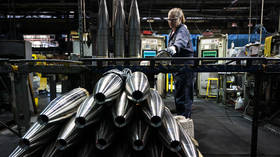Supermassive black holes exposed as glowing disks in striking X-ray (IMAGE)

Astronomers have deployed a new technique to capture X-ray images of spinning supermassive black holes billions of light-years away, one of which has reached the ‘point of no return’.
Spinning black holes create a swirling torrent of gas and dust around them. Rotating at phenomenally fast speeds and with temperatures reaching millions of degrees, the disks glow when pictured in X-ray light.
Also on rt.com Supermassive black hole caught ‘burping’ gas by NASA telescopesAstronomers used a new technique to measure the spin of five supermassive black holes, located between 8.8 billion and 10.9 billion light-years from Earth, using NASA’s Chandra X-ray Observatory.
The technique involves a combination of a natural phenomenon called a ‘gravitational lens’ and the Chandra equipment to study six quasars, each consisting of a supermassive black hole rapidly consuming matter from its surroundings.
The authors of the study, published in the Astrophysical Journal Tuesday, were then able to determine how fast the black holes were spinning, based on the size of the glowing disk around it.
Results showed one of the holes is spinning at, or almost at, the maximum rate possible. Known as the ‘point of no return’, the hole is hitting the speed of light (or about 670 million miles per hour). The other four studied are spinning at the average rate (about half the speed of light), while the sixth didn’t give an accurate estimate of spin.
Like this story? Share it with a friend!















